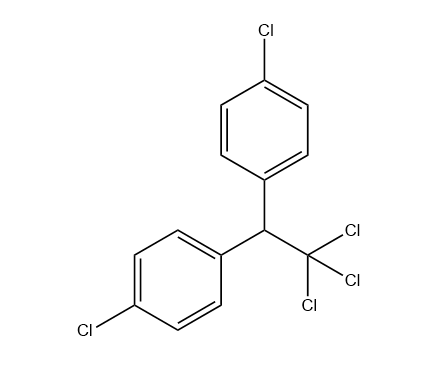
How many chlorine atoms are present in one mole of DDT?
Answer
222k+ views
Hint: DDT stands for dichlorodiphenyltrichloroethane which is an organic compound that exists as a tasteless and colourless crystalline solid. It is the chemical used as an insecticide in agriculture and widely used for controlling the pest to prevent malaria and typhus.
Complete Step by Step Solution:
The IUPAC name of DDT is 1,1,1-trichloro-2,2-bis(p-chlorophenyl)ethane and is a chemical compound belonging to the family of organic halogen compounds.
DDT is a low water soluble compound but is soluble in organic solvents, fats and oils. It is readily adsorbed to soil and has long term sources of exposure. DDT is known to be hydrophobic in nature which means the constituents of DDT are absorbed by the aquatic organisms in water.
The indirect exposure of DDT is non-toxic for humans. However, it is highly toxic and carcinogenic and its chronic exposure can cause adverse effects on health like breast cancer, etc.
The molecular formula of DDT is ${C_{14}}{H_{19}}C{l_5}$ and can be structurally represented as follows:

Hence, in one mole of DDT, the number of chlorine atoms present are 5.
Note: It is important to note that many countries banned the use of DDT as an insecticide because of its long term adverse effect. It was observed by the scientists that if DDT persists in the environment, it has the tendency to accumulate in fatty tissues and can cause severe health effects. Also, some insects resist the effect of DDT that means they eventually develop the ability to metabolise DDT, contradicting its main use.
Complete Step by Step Solution:
The IUPAC name of DDT is 1,1,1-trichloro-2,2-bis(p-chlorophenyl)ethane and is a chemical compound belonging to the family of organic halogen compounds.
DDT is a low water soluble compound but is soluble in organic solvents, fats and oils. It is readily adsorbed to soil and has long term sources of exposure. DDT is known to be hydrophobic in nature which means the constituents of DDT are absorbed by the aquatic organisms in water.
The indirect exposure of DDT is non-toxic for humans. However, it is highly toxic and carcinogenic and its chronic exposure can cause adverse effects on health like breast cancer, etc.
The molecular formula of DDT is ${C_{14}}{H_{19}}C{l_5}$ and can be structurally represented as follows:

Hence, in one mole of DDT, the number of chlorine atoms present are 5.
Note: It is important to note that many countries banned the use of DDT as an insecticide because of its long term adverse effect. It was observed by the scientists that if DDT persists in the environment, it has the tendency to accumulate in fatty tissues and can cause severe health effects. Also, some insects resist the effect of DDT that means they eventually develop the ability to metabolise DDT, contradicting its main use.
Recently Updated Pages
Types of Solutions in Chemistry: Explained Simply

States of Matter Chapter For JEE Main Chemistry

Difference Between Alcohol and Phenol: Structure, Tests & Uses

Conduction Explained: Definition, Examples & Science for Students

Balancing of Redox Reactions - Important Concepts and Tips for JEE

Atomic Size - Important Concepts and Tips for JEE

Trending doubts
JEE Main 2026: Application Form Open, Exam Dates, Syllabus, Eligibility & Question Papers

Derivation of Equation of Trajectory Explained for Students

Hybridisation in Chemistry – Concept, Types & Applications

Understanding the Angle of Deviation in a Prism

How to Convert a Galvanometer into an Ammeter or Voltmeter

Degree of Dissociation: Meaning, Formula, Calculation & Uses

Other Pages
Solutions Class 12 Chemistry Chapter 1 CBSE Notes - 2025-26

NCERT Solutions For Class 12 Chemistry Chapter 1 Solutions - 2025-26

The D and F Block Elements Class 12 Chemistry Chapter 4 CBSE Notes - 2025-26

NCERT Solutions for Class 12 Chemistry Chapter Chapter 7 Alcohol Phenol and Ether

NCERT Solutions ForClass 12 Chemistry Chapter Chapter 8 Aldehydes Ketones And Carboxylic Acids

JEE Advanced Marks vs Ranks 2025: Understanding Category-wise Qualifying Marks and Previous Year Cut-offs




